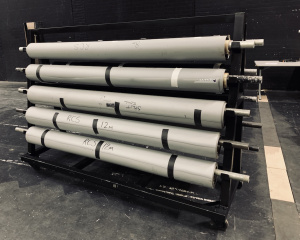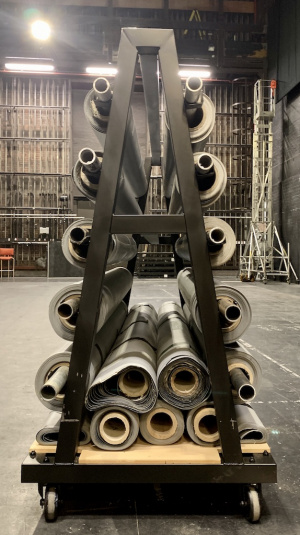Dance Floor
Dance Floor is a performance surface. It can be used for sprung floors, ballet, or sport.
Stock
The stock is kept on two dance-floor trolleys. The first trolley, the smaller of the two, is for the Athenaeum and holds 6 rolls of Harlequin reversible dancefloor that are used as a BLACK dance-floor. These floor rolls are as follows:
- DF 1 SL (2000 x 6500mm) Split Roll - Joins DF 1 SR on centre (see below diagram)
- DF 1 SR (2000 x 6500mm)
- DF 2 (2000 x 13300mm)
- DF 3 (2000 x 13300mm)
- DF 4 (2000 x 13300mm)
- DF 5 SL (2000 x 13300mm)
- Spare (200 x 6500mm) Split Roll


The second dance-floor trolley holds 10 rolls and this is primarily floor for the Chandler, AGOS, rehearsal rooms and external venues. There are a few different floors on here and they are:
Harlequin reversible GREY / BLACK
2000 x 12000mm x 4 Rolls
2000 x 8000mm x 3 Rolls
Le Mark reversible WHITE / BLACK
2000 x 12000mm x 3 Rolls


Other Sources of Dance Floor
The production manager of the show should contact Scottish Ballet if more floor is required.
Layout of Athenaeum Floor
Laying Dance Floor
This method requires 4 personnel, dance-floor, 2 brooms, gaffer tape and dance-floor tape.
Layout your entire floor and allow it to settle and warm up. Once in position, gaffer tape one end fully down and you need to get some air under the floor to allow tensioning to take place. The easiest way to do this is for someone to flick the long edge up all along the length of the floor. Next, place two personnel 'pullers' at the un-taped end of the floor ready to take tension and the remaining two personnel 'sweepers' each get a broom and get ready at the taped end. Tension is then applied by the two 'pullers' by pulling on the floor, carefully keeping it in line with the desired position. The sweepers then sweep the air out of the length of the dancefloor careful to remain standing on the dancefloor at the end until the pullers can get that end taped, once again with gaffer tape.
Repeat this process for all the rolls in use, being careful to keep around 5mm between each roll.
Once this has been completed, it's time for the long lengths to be taped. Split into two teams of two for taping. Using the dance-floor tape, fix at one end and one person keep pressure on this with a foot as the second person pulls out around 5m of tape out of the roll and lay it carefully down on the join. The person putting foot pressure on can then secure the tape down by either using a folded up towel or piece of tat or a small broom.
Repeat this process for all internal joins. The outer joins can then be taped with gaffer if required.
Cleaning and Care
There are clean mops for dance-floor as of June 2017. These can be accessed from the TSM Lecturer or Tutor.
In addition to the dance floor mops there are two dance floor towel mops and four towel coverings. Before June 2017 the solution for dusting dance floor was clipping a damp towel around a normal broom. This is no longer necessary.
Step One – Dry Mop • Firstly make sure that the dry mop (red and fluffy) has been hoovered and is clean. • Start either upstage or downstage and run the mop along the length of the floor. Turning at each corner. Do not lift the mop while doing this. Shake out once complete. • Hoover it once you are finished with the dry mop.
Step Two – Not always necessary ( See note below) • Using CIF (or something similar) fill a bucket with hot water. There will be directions on the back of the bottle as to how much CIF to add to the amount of liquid • Wring out the mop and work your way along the floor. Tackle one length at a time going in a side to side motion. • Empty the bucket and fill with warm water again to rinse out the mops to prepare for step three.
this process is only done when the floor becomes slippery, it will not have to be done each day. Step Three - Meths • Fill the bucket with hot water and add a glug of methylated spirit to this. (Purple and in COSHH cupboard). • Mop the floor, this is done in runs from one side of the stage to the other. You should get twice across the stage and back again before having to rinse out your mop.
Step Four – General Venue Clean • Make sure that the wings are swept and hoovered. It is a good idea to take the mop with meths off stage to pick up any dust. • Hoover the void/backstage area thoroughly.
- This process should take 30 minutes with two people.
Step Five – What to do in between breaks • During food breaks, especially during the tech run the floor can pick up a lot of dust so must be dealt with. • There is a large squeegee in the venue's office; you place a slightly damp towel over it then go over the stage from side to side. Do not lift until the end • This is a good way to freshen up the floor when there isn't the time for a full mop.
